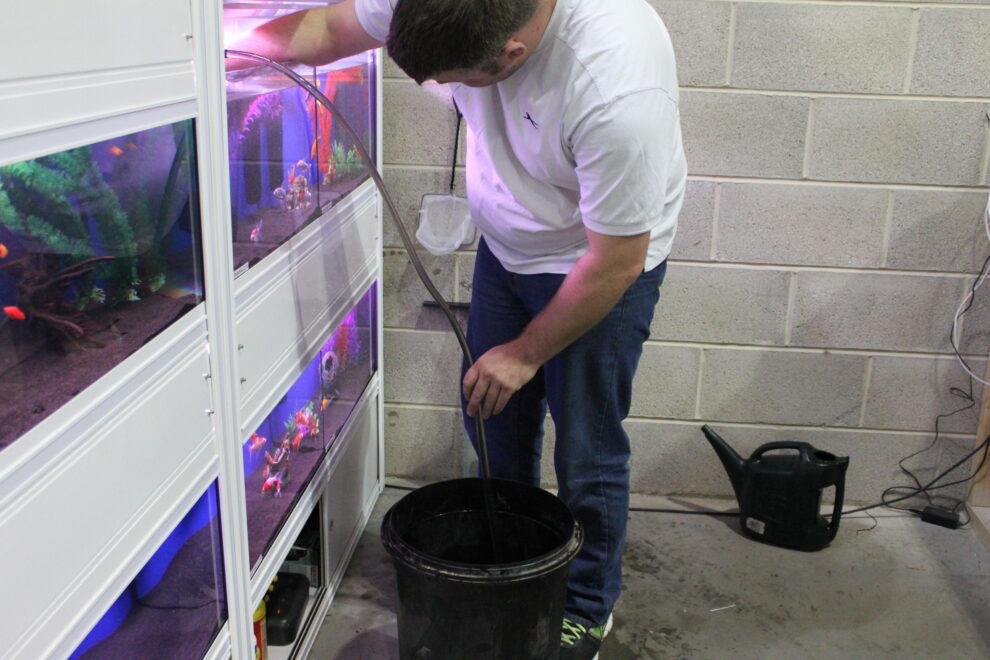Aquatic Knowledge
How to Do a Water Change in an Aquarium: The Ultimate Guide
Maintaining a clean and healthy aquarium environment is essential for the well-being of your fish. One of the most crucial tasks in aquarium care is performing regular water changes. How to do a water change in an aquarium may seem simple, but it requires careful attention to detail and consistency to ensure your aquatic ecosystem thrives. In this comprehensive guide, we’ll explore the step-by-step process of performing a water change, along with tips and tricks to make the task easier. Whether you’re new to aquarium maintenance or looking to improve your routine, this article will help you master the process.
What Is a Water Change and Why Is It Important?

A water change involves replacing a portion of the old, contaminated water in your aquarium with fresh, clean water. This helps remove harmful waste products like nitrates and ammonia, which can build up over time, negatively impacting your fish and plants.
The importance of water changes cannot be overstated. Fresh water replenishes essential minerals and nutrients, dilutes toxins, and helps maintain the right water chemistry for your fish. Without regular water changes, your aquarium can quickly become an unhealthy environment.
How Often Should You Do a Water Change?
The frequency of water changes depends on several factors, including the size of your tank, the number of fish, and the type of filtration system you use. A general rule of thumb is to change 10-20% of the water in your tank every one to two weeks.
However, if your tank is heavily stocked or if you’re dealing with issues like algae growth or cloudy water, more frequent water changes may be necessary. Keeping an eye on your water parameters using test kits will help you determine when a change is needed.
Signs That Your Aquarium Needs a Water Change
Knowing how to do a water change in an aquarium is essential, but recognizing when it’s time for a water change is equally important. Here are some signs that your tank may need a refresh:
- Cloudy Water: Cloudy or murky water is a clear indication that waste and debris are accumulating, and a water change is overdue.
- Excessive Algae Growth: Algae thrive in environments with high nutrient levels. If your tank is overrun with algae, a water change can help balance the nutrient levels.
- Fish Gasping at the Surface: If your fish are frequently gasping for air at the surface, it could indicate low oxygen levels, often a result of poor water quality.
How to Do a Water Change in an Aquarium: Step-by-Step

When it comes to how to do a water change in an aquarium, there are several key steps to follow to ensure the process is safe and effective. Let’s dive into the detailed process.
Step 1: Gather Your Supplies
Before starting a water change, gather all the necessary tools:
- A siphon or gravel vacuum
- A clean bucket reserved for aquarium use
- Water conditioner
- A thermometer (if adjusting water temperature)
Step 2: Turn Off Aquarium Equipment
To avoid damage or accidents, turn off your aquarium’s filter, heater, and other equipment. This ensures safety and prevents water from splashing onto electrical components during the process.
Step 3: Siphon Out Old Water
Using a siphon, carefully remove about 10-20% of the water from the tank. Place the other end of the siphon in the clean bucket. Make sure you’re removing water from the bottom of the tank where debris tends to accumulate.
Step 4: Clean the Gravel
As you siphon out the water, gently use the gravel vacuum to clean the substrate. This helps remove fish waste, uneaten food, and other debris that can build up over time. Be careful not to disturb plants or decorations too much during this step.
Step 5: Prepare Fresh Water
Before adding new water, make sure it’s properly treated with a water conditioner to neutralize harmful chemicals like chlorine. Also, ensure the temperature of the new water is similar to that of the tank to avoid shocking your fish.
Step 6: Add Fresh Water to the Aquarium
Slowly pour the treated water into the tank using the clean bucket. Avoid pouring too quickly to prevent disturbing the substrate or plants. You can pour onto a plate or other surface in the tank to minimize water agitation.
Step 7: Turn Aquarium Equipment Back On
Once the water has been replaced, turn your filter, heater, and other equipment back on. Ensure everything is working correctly and that the water levels are appropriate.
Step 8: Monitor Your Fish
After completing the water change, take a few minutes to observe your fish. Look for any signs of stress or unusual behavior. If you notice anything concerning, double-check your water parameters to ensure everything is in balance.
Signs That Your Aquarium Needs a Water Change

Knowing how to do a water change in an aquarium is essential, but recognizing when it’s time for a water change is equally important. Here are some signs that your tank may need a refresh:
- Cloudy Water: Cloudy or murky water is a clear indication that waste and debris are accumulating, and a water change is overdue.
- Excessive Algae Growth: Algae thrive in environments with high nutrient levels. If your tank is overrun with algae, a water change can help balance the nutrient levels.
- Fish Gasping at the Surface: If your fish are frequently gasping for air at the surface, it could indicate low oxygen levels, often a result of poor water quality.
Benefits of Regular Water Changes
There are many reasons to regularly perform water changes in your aquarium. Some of the key benefits include:
- Improved Water Quality: By removing harmful chemicals like ammonia, nitrites, and nitrates, water changes keep your tank water clean and safe for your fish.
- Enhanced Fish Health: Clean water leads to happier, healthier fish, reducing the risk of diseases and stress.
- Better Aesthetic Appeal: Regular water changes ensure your tank stays crystal clear, enhancing its overall beauty.
Tips for Making Water Changes Easier
Water changes don’t have to be a daunting task. Here are some tips to make the process smoother:
- Set a Schedule: Create a routine for water changes and stick to it. Consistency is key to maintaining a healthy tank.
- Use a Gravel Vacuum: A gravel vacuum makes it easy to remove debris and clean the substrate while siphoning out water.
- Invest in a Water Changer System: These systems can automate the process, making water changes quicker and less messy.
How to Maintain Water Quality Between Water Changes
In addition to regular water changes, there are a few steps you can take to maintain water quality between changes:
- Feed Sparingly: Overfeeding leads to excess waste in the tank. Only feed your fish what they can eat in a few minutes.
- Monitor Filtration: Ensure your filter is working properly and clean it regularly to prevent clogs.
- Test Water Parameters: Regularly test your water for ammonia, nitrites, nitrates, and pH levels to catch any issues early.
Conclusion
Performing regular water changes is one of the best things you can do to maintain a healthy aquarium. By following these steps on how to do a water change in an aquarium, you’ll ensure that your tank remains a clean, thriving environment for your fish. Remember to stay consistent with your water change routine and monitor your water quality regularly. A little effort goes a long way toward keeping your aquarium beautiful and your fish healthy.
FAQs
- How often should I change the water in my aquarium?
The frequency of water changes depends on various factors such as tank size, number of fish, and filtration system. Generally, changing 10-25% of the water weekly is recommended. - Can I use tap water for my aquarium?
Yes, you can use tap water, but it’s essential to treat it with a dechlorinator to remove harmful chlorine and chloramines before adding it to your tank. - What should I do if my fish look stressed after a water change?
If your fish appear stressed after a water change, check the water temperature and parameters to ensure they match the tank conditions. Gradual changes and using a water conditioner can help reduce stress. - How do I know if my water quality is good?
Regularly test your water for ammonia, nitrites, nitrates, and pH levels. Good water quality typically means low levels of ammonia and nitrites, with nitrates kept in check and a stable pH level. - Are there any alternatives to manual water changes?
Automatic water changers can be a convenient alternative for maintaining water quality with minimal effort. These systems perform regular, partial water changes automatically, helping to keep your tank healthy.
